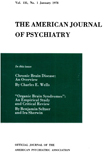FACTORS AFFECTING THE ELECTROENCEPHALOGRAM OF PATIENTS WITH NEUROSYPHILIS
Abstract
Fifty percent of 233 cases of neurosyphilis had abnormal EEGs. The incidence of abnormality in the various clinical types of neurosyphilis was as follows: meningovascular lues 60 percent; general paresis 55 percent; optic nerve atrophy 44 percent; tabes 14 percent. In a control group the incidence of abnormality was 10 percent. Tabes, therefore, did not have a significantly greater incidence of abnormal EEGs than controls; on the other hand, the incidence of abnormality in optic atrophy, general paresis and meningo-vascular lues was significantly greater than in control subjects.
Twenty percent of the total cases with neurosyphilis had positive histories of seizures as compared to an incidence less than one percent in the general population. The meningo-vascular type of neurosyphilis had the highest incidence of seizure histories and a large proportion were of the Jacksonian variety. The next highest incidence of seizures occurred in cases of general paresis and they were mostly of the grand mal and "atypical" variety. No cases with a history of seizures occurred in the groups diagnosed tabes dorsalis or optic nerve atrophy.
A very high incidence of abnormal EEGs (90 percent) occurred in the cases with a history of seizures. The more abnormal the EEG. in any given case of neurosyphilis, the greater the likelihood that the patient had a history of seizures. The paroxysmal type of EEG. abnormality was the most specific for the seizure disorders.
In a group of cases of general paresis a number of clinical and laboratory findings were correlated with the incidence of EEG. abnormality with the following results: The incidence of EEG. abnormality was highest in patients with a history of seizures. The presence of tremors, dysarthria, abnormal reflexes or an "organic" mental picture also raised the incidence of EEG. abnormality, but not as high as did the presence of a history of seizures. A slightly positive correlation was obtained between numbers of white blood cells, amount of total protein, severity of colloidal gold reaction in the cerebro-spinal fluid and incidence of EEG. abnormality. No correlation was obtained between EEG. abnormality and abnormal pupils, or between EEG. abnormality and presence of delusions or hallucinations as a primary part of the mental picture.
A study of all cases in relation to age revealed that the largest number of cases of neurosyphilis were in the 40-50 year age group. The incidence of epilepsy and of abnormal EEGs was lowest in this age group. There was a rise in the incidence of fast activity with age and a fall in the incidence of slow activity with age. This trend in cases of neurosyphilis parallels the trend previously observed in control subjects and in neuropsychiatric patients.
Access content
To read the fulltext, please use one of the options below to sign in or purchase access.- Personal login
- Institutional Login
- Sign in via OpenAthens
- Register for access
-
Please login/register if you wish to pair your device and check access availability.
Not a subscriber?
PsychiatryOnline subscription options offer access to the DSM-5 library, books, journals, CME, and patient resources. This all-in-one virtual library provides psychiatrists and mental health professionals with key resources for diagnosis, treatment, research, and professional development.
Need more help? PsychiatryOnline Customer Service may be reached by emailing [email protected] or by calling 800-368-5777 (in the U.S.) or 703-907-7322 (outside the U.S.).



